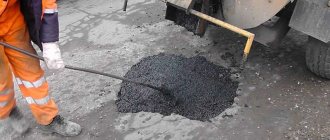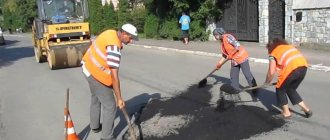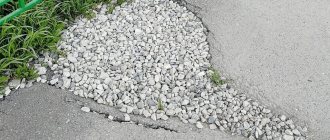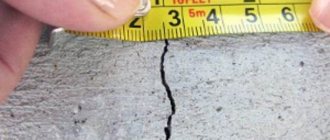Asphalt concrete is used to construct road surfaces in many countries around the world, as it has high performance characteristics that are excellent for these purposes. However, like most existing materials, asphalt is destroyed under the influence of time and external factors, which requires asphalt repair.
“Depending on the type of damage the canvas received, you can resort to local or major repairs of the coating. Sometimes it is enough to simply repair the crack, but the service life of the road surface is influenced by a number of factors, due to which in some cases the best solution is to dismantle the existing asphalt in order to re-pave it.”
Asphalt repair allows you to quickly return the surface to a safe condition, as well as significantly extend the life of roads and pedestrian areas. There are also preventative methods that can prevent serious damage.
Why does asphalt deteriorate?
The wear rate of asphalt pavement is influenced by both natural and human factors. Natural factors include low and high temperatures, as well as temperature changes. In addition, an important parameter is the load on the road surface - the higher and more intense it is, the faster the coating will wear out, which may result in the need for asphalt repair.
In general, the reasons for the destruction of the road surface include the following:
- Load on the roadway and its intensity;
- Insufficient coating thickness;
- Low and high temperatures, as well as changes;
- Other climatic conditions;
- Poor quality materials from which the coating and its base are made;
- Failure to comply with asphalt laying technology;
- some other factors.
At the same time, if asphalt repairs are carried out as soon as any defects begin to appear, major repairs can be significantly delayed.
Advantages
The right approach to coating development allows us to carry out effective repairs. Each client is guaranteed that the order will be completed within the required time frame. All services are guaranteed for 3 years. Repairs are carried out without other contractors, which allows us to offer low prices to the customer. Asphalt-Doroga LLC is a leader in asphalt paving and road repair. More than 15 years of work in the construction market, many orders have been completed at a high level of quality.
✔We will carry out preliminary diagnostics
✔ We will develop a clear plan, which can be adjusted if necessary
✔ We will select the optimal road repair technology
✔ Customers have a pre-installed loyalty program
✔ Discounts and bonuses!
We have been repairing roads of varying complexity for many years. There is a modern fleet of special equipment for high-quality major repairs. Reliable road surface repair is necessary for comfortable movement of car owners. Asphalt-Doroga LLC works only with high-quality materials from the best brands. Our team employs only professionally qualified personnel, each specialist has extensive practical experience.
Local asphalt repair
Asphalt pothole repair is the most common method used to restore the integrity of the pavement. Despite the name, this type of repair is suitable for eliminating not only holes, but also cracks, potholes and other things.
There are several types of local patching repairs:
- Jet-injection method;
- Rehabilitation of cracks;
- Asphalt repair with cold mixtures;
- Repair with hot asphalt;
- Repair with cast asphalt.
Hot mix
If there are asphalt concrete plants nearby that produce hot asphalt, it is better for them to carry out pothole repairs in winter. This takes into account the natural features of the climate, the duration of winter, the depth of soil freezing, and the average value of winter temperature indicators. The amount of frozen soil should not be more than 70%, its maximum thickness should not be more than 30 cm. The estimated height of the subgrade in the presence of frost is no more than 2.5 m.
The main condition is to maintain +80 C° heat in the building material. When preparing the pothole, you must first trim it, thoroughly clean and prime it, warm it well, and only then paving. Compliance with all technologies ensures longer subsequent operation of the road. In addition, in cool times the material cools faster, which means that traffic in this area will be restored in about half an hour.
Jet-injection scheme
Suitable for repairing small defects. These could be holes, cracks or potholes. Before restoration begins, the damaged area must be cleaned of dirt, dust and debris, which can be done with air pressure. It is also recommended to dry the repair area before repairing the damage.
After this, the damaged area is treated with a water-bitumen emulsion, covered with fine crushed stone, and then treated again with a water-bitumen emulsion. After laying, the crushed stone must be properly compacted to ensure sufficient performance of the patch.
Repairing asphalt using the jet-injection method involves the use of crushed stone from hard rocks, the size of the fractions is 0.5-1 cm. This type of repair can be carried out in different seasons, since the required air temperature is from -15 to +40°C.
For such repairs, a special repair machine is used. It is capable of both qualitatively cleaning the repair area even from hard dirt (with air under pressure), as well as applying an emulsion and filling with crushed stone. Compaction is carried out using manual equipment.
Where is jet-injection asphalt repair used:
- parking;
- sidewalks;
- other pedestrian areas;
- areas with low traffic load.
The method is not suitable for public roads, since such a patch will not withstand the pressure of heavy vehicles.
How to Repair Small Potholes and Cracks
Sometimes it seems that it is enough to simply fill an empty hole with crushed stone or new asphalt. This method is often used by inexperienced builders. But this is only a temporary measure, the pothole will almost certainly appear again, and the area between the old and new surface will become the weakest part of the road.
There are several steps to follow to properly repair a pothole. They may vary depending on the size of the defect. Workers will:
- Cleaning. The hole can be easily cleaned by hand or with simple tools - shovels and rakes. First, small pieces of stone, asphalt and other debris are removed. The fines are removed with water, sand or air supplied under pressure. Thorough cleaning ensures reliable adhesion of the filler to the old material.
- Measuring the depth, length and width of a pothole. This gives a good idea of how much asphalt will be needed and if other equipment is needed.
- Pouring the asphalt mixture. If there are cracks, in order to save sealant, a backing rod can be laid first. It is designed to strengthen the structure and reduce the cost of base material. The backing rod must be incompressible, non-shrinking and non-absorbent, and must have a higher melting point than the mixture used to fill the crack.
Rehabilitation of cracks
Some experts do not classify the rehabilitation of cracks as patching repairs, since these manipulations are carried out even before major damage occurs. However, there is no significant difference in how to classify such asphalt repairs, the main thing is its effectiveness.
Rehabilitation of cracks is a method in which seams and cracks are treated and sealed with polymer or bitumen compounds. This allows you to prevent further destruction of the canvas, eliminating damage at the initial stage of their formation. With timely treatment, this method can extend the service life of a road section to 5-7 years.
Before starting the procedure, it is necessary to clean the crack from dust, dirt, debris and moisture, as required by any asphalt repair. This is done by air pressure, as well as a heat lance.
There are 2 main ways to rehabilitate cracks:
- pouring method;
- filling method.
Fill method
Suitable for small cracks up to 50 mm wide. It involves removing the damaged coating layer to the full depth along the resulting crack in order to give the repair object the correct geometric shape. For this purpose, special equipment is used - a seam and crack separator.
After this, the resulting reservoir is filled with a sealing material, the quality of which will determine the quality of the patch. The process of filling the sealant is carried out using melting and pouring machines.
Filling method
used for larger cracks over 50mm wide. Also suitable for branched complex cracks, and does not require cutting the damaged area (no need to expand and give the correct geometric shape).
Otherwise, the process is similar to pouring - after cleaning and drying, the cavity must be filled with a sealing material, which is bitumen mastics.
This method is suitable for both public roads and pedestrian areas.
Advantages and disadvantages of cold mix technology
When using hot asphalt, its production must be carried out in a short time. In this case, special equipment is used. Cold mixtures retain their characteristics when stored openly for two months. The packaged material can be stored for 8 months.
The price for pothole repair in Moscow using cold mixtures is lower than the cost of work using hot asphalt. Modified bitumen and special additives expand the range of climatic conditions, allowing asphalting at temperatures down to -10ºС. Moreover, the packaged organomineral mixture:
- Does not require special equipment (except for a gas burner to heat the surface);
- Can be laid in potholes without preliminary cutting;
- No special requirements for transportation;
- Does not require special labor qualifications.
On the other hand, the laid and compacted organomineral mixture is characterized by low shear resistance, which does not allow it to be laid in places where vehicles slow down. The combination of price and quality of the material characterizes it as a means for quickly eliminating potholes when winter sets in, that is, outside the traditional road work season, and as a means of preventing increased damage during the winter period.
The injection or jet-injection method is a special case of working with cold asphalt concrete mixtures. Appropriate installations (for example, UYAR-1 or foreign analogues) allow you to quickly repair small and medium-sized damage to the road surface, even without cutting. A single unit performs all the preparatory and main stages of repair, and additional compaction is not required due to the application of the mixture under pressure.
Pothole repair with asphalt concrete
We include asphalt repair with conventional asphalt concrete as this type of repair. This type of asphalt repair is suitable for both highways and pedestrian areas. For roads of categories II and I, hot or cast asphalt is used, and for ordinary roads, cold asphalt concrete is also suitable.
The procedure can be performed with the following types of asphalt mixtures:
- cold;
- hot;
- cast.
Each type of asphalt concrete has its own characteristics, both in composition, repair technology, and air temperature at the time of work.
Asphalt repair with cold mixtures
A fairly simple way to eliminate holes and potholes, which can be done even in cold weather. Another advantage of this type of asphalt concrete is that it does not require heating before laying. However, cold mix has lower performance than hot or poured asphalt.
Asphalt repair with hot mixes
can be produced at an air temperature of +5°C, and the mixture must be heated to 110-130°C or at least 100°C. A hot battery has higher physical and mechanical characteristics than a cold one.
Repair technology with cold and hot asphalt:
- Cleaning the repair area from debris, dirt, dust and moisture, etc.;
- Aligning the edges of the damaged area;
- Treatment of the area with liquid bitumen at the rate of 0.5 l/1m2;
- Laying fine crushed stone with subsequent compaction (if the damage depth is more than 20 cm);
- Laying asphalt (2 cm above the required level);
- Compaction of the asphalt layer.
The level should be taken higher, since after compaction it will drop. Compaction is carried out using manual equipment or road rollers.
«Difference in repair technologies
between these two mixtures is that the second option is more mechanized, its application requires the use of special equipment. The first option can only be carried out using manual equipment.”
Asphalt repair with cast mixtures
differs significantly from the two previous options. Firstly, cast asphalt has higher performance characteristics than previous options, but its cost will be higher. Secondly, cast asphalt has a liquid consistency and does not require compaction, as it independently gains density and hardness during the cooling process.
Repair technology with cast asphalt
differs from hot and cold mix technology only in that cast asphalt does not require compaction. Otherwise, everything is the same: prepare the repair area, and then fill it with the cast mixture.
Major asphalt repairs
Major asphalt repairs can be of two types:
- 1. Complete 100% restoration of the roadway, including replacement of the base, and sometimes restoration of the subgrade.
- 2. Removing the top layer of asphalt to lay new asphalt.
The first option is more radical, and is used when the condition of the entire road surface is unsatisfactory. However, in most cases, if we talk about modern roads, such large-scale intervention is not required.
The second option is performed using the milling method
, using special road milling machines. Initially, the hot milling method was used, which involved preheating the coating before removing it. This surface was fairly easy to cut, but the method had several disadvantages, including a more complex process and the inability to reuse the cut asphalt.
Today the cold milling method
. Repairing asphalt using this method is more technologically advanced, and also allows you to produce asphalt chips directly on site from the removed coating, which can be reused.
This is done by converting the cut layer into asphalt granulate, with the ability to set the size of the fractions. Also, with the help of modern road milling machines, you can adjust the milling depth.
Cold milling technology:
- 1. The road milling machine cuts the asphalt pavement to a given depth, processing it into granulate for subsequent use;
- 2. The surface, if necessary, is cleaned of dust, dirt and moisture;
- 3. Treatment with bitumen emulsions occurs;
- 4. Fresh asphalt is laid using asphalt pavers;
- 5. This is followed by compaction with road rollers if hot asphalt concrete is used.
This method of asphalt repair not only renews the surface, but also strengthens it. Before laying new asphalt concrete, a geogrid can be laid, which will act as a reinforcing material, increasing the strength of the roadway.
Stages of work
It is performed with or without cutting the existing layer. In the first case, it is necessary to remove the old coating that has become unusable. When performing work, the following technology is observed:
- First of all, temporary signs are installed to restrict the movement of vehicles along the repaired area.
- All contaminating elements, as well as ice, snow and dust, are removed.
- Places to be repaired are marked. After which a repair map is drawn up.
- Using special cutters, the contours of defective sections of the road are cut.
- The surface of the resulting contours is cleaned of dirt and debris.
- The walls and bottom of potholes are heated with gas equipment and treated with a special composition based on organic substances.
- The cold asphalt mixture is laid into the pothole in layers, with each layer being obligatory compacted.
- Quality control of each pit repair.
- Storing waste and removing it outside the repaired lane, as well as restoring traffic.
conclusions
Asphalt repair may be required due to natural reasons such as wear and tear or the harsh climate of the region, or due to violations of asphalt paving technology or the use of low-quality materials. However, in any case, the asphalt surface can be restored.
In some cases, when damage is at the initial stage of formation, the service life of the canvas can be significantly extended by repairing cracks
, and minor damage to pedestrian areas is eliminated
using the jet-injection method
.
Larger local damage to the road surface can be corrected using asphalt patching
, which can be produced by various types of asphalt concrete.
There is also asphalt repair using milling method
, used for larger-scale canvas repairs. The method involves cutting off the top layer of pavement using a road milling machine, as well as subsequent laying of fresh asphalt concrete.
As a last resort, you can completely repair the roadway, starting from the very foundation, but this method is not often required.
Why is it difficult to repair potholes in cold weather?
Snow, ice, and water naturally accumulate in potholes, making them difficult to remove. Patches can be a temporary solution to the problem, but they must fit snugly to the edges of the coating and be laid on a well-dried surface. Otherwise, the remaining moisture will expand as it freezes, causing cracks to appear.
Patches are only effective when installed correctly. In winter, they do not have time to cool down, stick to the tires and are pulled out by them, washed out by rains and floods, and destroyed due to rubbing of accumulated water.
The best conditions for asphalt work are when the temperature reaches 20-22 C°. But even if you don’t like the idea of starting them in December or January, in some cases you shouldn’t wait, because this can provoke:
- Additional damage caused by the freeze/thaw cycle
- Risk of injury to pedestrians or damage to vehicles.
- Possibility of water seeping under asphalt
- Refusal of customers to use parking lots or highways.











